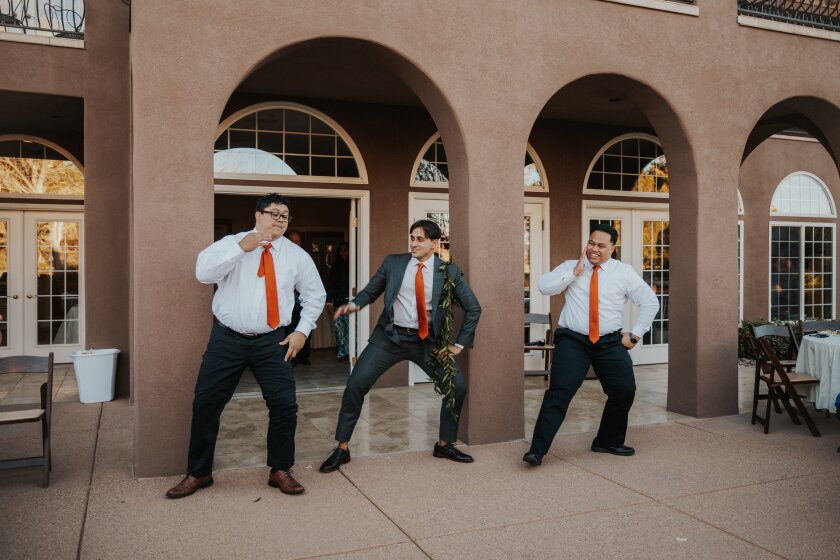
Recalling heartfelt memories of their wedding days, couples shared how they incorporated cultural traditions from their homes into their special days. They said learning about their partner’s traditions allowed them to better integrate culturally significant traditions in their ceremonies.
Ellisa Hadley Edeyaoch, a sophomore from the Federated States of Micronesia majoring in Pacific Island studies, said it is common for men in Micronesian culture to ask for the woman’s hand in marriage with his clan or his family and to bring a sakau, a special plant drink. “It serves as a peace offering, and if the girl accepts, they are considered married in the eyes of society,” Edeyaoch explained.
Due to COVID-19, Edeyaoch said they weren’t able to follow all of the Micronesian wedding traditions on her wedding day. She explained usually they invite a nahnwarki, or leader, that helped advise the couple. She asserted due to the current circumstances, they weren’t able to go home even though she wished she had a traditional wedding.
Kaytano Edeyaoch, a junior from the Republic of Palau majoring in information technologies, agreed with his wife, saying he wished they could have held a traditional wedding. He explained men are supposed to collect traditional stone money along with paper money to give to the bride’s family.
“It shows the wife’s family what kind of family the daughter is marrying into. It shows that she is going to be in a stable family,” he explained.

Zhang Zhi Yun, a sophomore from Taiwan majoring in art, shared in her home country it is common for weddings to be fairly westernized. However, she said the groom must get the parents approval in order to marry their daughter. In Taiwan, she said the man must bring gifts to the girl’s family in order to marry her. He also needs to have a house, car and good education to prove he can provide for her.
Yun said both her and her husband’s cultures traditionally expect a big wedding ceremony, but due to COVID-19, they were not able to go back to their home countries and were not able to invite a lot of people, including their parents.
Rahul Chinna Mungamuri, a sophomore from India majoring in business management, said they covered themselves in turmeric powder, which is a common wedding tradition of India called haldi. He explained they did this before the wedding ceremony in order to cleanse themselves.
He explained, “Haldi is a tradition in India that is believed to clean and purify our bodies. It is also believed to prevent evil spirits.” Mungamuri said it is a Hindu religious tradition and is followed by most people in India.
In traditional Indian weddings, he added, the bride and people in attendance will do mehndi, a tattoo on the hands using henna. “The bride’s hands and all her friends get it on their hands.”

He said the paste is associated with good spirits, good luck, health and prosperity. Traditionally, the bride’s designs are the most intricate to set her apart from the rest of the bridal party, he said. Mungamuri said he and his wife wish to return to India to have a more traditional reception.
Clarissa Tekeiaki, a Spring 2020 graduate and EIL adjunct faculty from Nevada, said they were able to incorporate both American and Kiribati traditions into their engagement and wedding.
She explained in Kiribati culture, wedding rings aren’t common. Instead, the bride receives gold earrings to wear leading up to the wedding. She said, “I got my ring, and I wore the earrings that were given to me to incorporate both of our cultures.”
Clarissa Tekeiaki said traditionally, American cultures focus on the aesthetic and the decorations. “I wanted to make it an experience, so we decorated really fancy and had lights and chandeliers and had a very romantic vibe.”
She said her husband’s family from Kiribati didn’t pay much attention to the decorations but said the food and the reception were much more important to them. Being able to incorporate both cultures made it enjoyable and special, she added.
Timeon Tekeiaki, a senior from Kiribati majoring in accounting, shared weddings from his hometown are usually a big celebration. A week before the wedding, the families get together to prepare the food, he explained. He expressed gratitude to his brother and his wife who were able to go back to Kiribati to get traditional foods to have at their reception.
During the reception, he shared, they do a cake dance where someone dances with the cake to a Kiribati song as they bring it to the bride and groom’s table. He explained other traditional dances done by guests are out of respect for the couple and show their support for them.
Sydney Sears, a junior from China majoring in marketing, said for both her and her husband, a lot of traditions surround food. She said they tried to give their wedding a tropical feel with both the food and the decorations. Although COVID-19 didn’t allow them to have a long guest list, they still had a lot of food from both Asia and Samoa, she asserted.
She said, “From my side, we had curries and egg rolls, and for my husband’s side, we had palusami, chop sui and kalua pig.”
Sears said she was grateful to have a more intimate wedding because it made her ceremony seem more relaxed and put less pressure on her to appeal to high expectations.

Saane Hullinger, a senior from Tonga majoring in social work, said Tongan traditional weddings have a lot of dances, including a tauolunga, which is usually performed by people related to the bride and groom. She explained the last dance is usually performed by the bride and the motions are beautiful and graceful.


